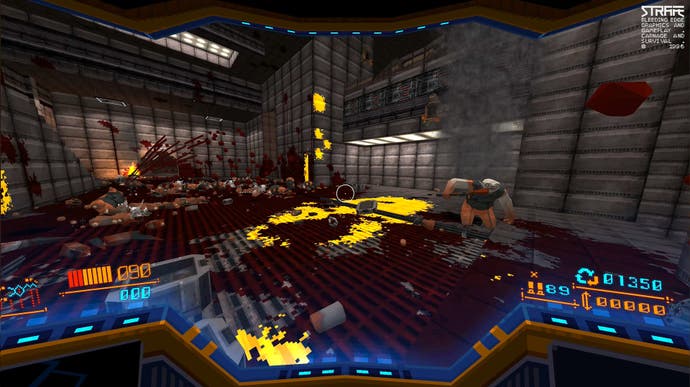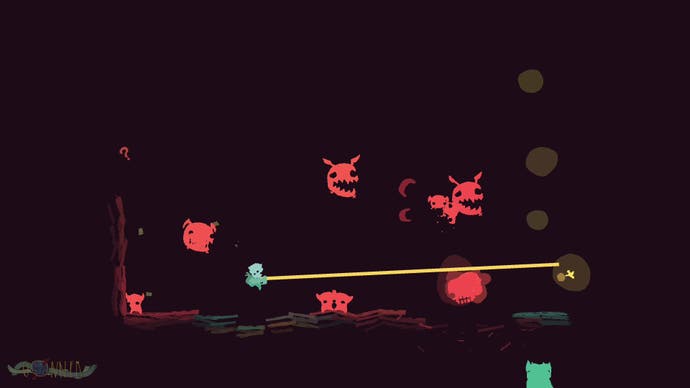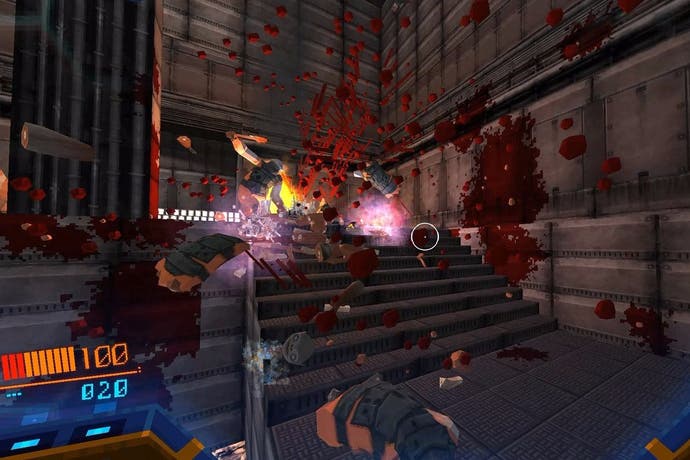How Strafe and GoNNER reimagine Spelunky as a shooter
Buried pleasure.
The action roguelike has quickly become among my favourite video game genres. It started with Mossmouth's delectable action platformer Spelunky and has quickly expanded into other polished procedurally-generated adventures like The Binding of Isaac, Nuclear Throne, Downwell, Enter the Gungeon, and Galak-Z. There's something simultaneously bite-sized and epic about growing from a scrappy wayfarer to a veteran hero with a Gandalfian bag of tricks up your sleeve.
This year at PAX East I played two upcoming games that capture this condensed journey shockingly well. Coincidentally, they both involve a lot of shooting.
The first one is is Strafe, a 90's inspired first-person shooter that made a name for itself with an incredible live-action Kickstarter video. That pitch dictated the retro tone of Strafe, but didn't hint at its Spelunky-esque structure of multiple zones with a few stages each, nor is it immediately obvious in video form what makes Strafe's current build so, so good.
Like any great roguelike, the devil is in the details. Most shooters these days treat enemy guns as realistic entities that splatter you with bullets before you have time to react. As such, you're often hiding behind cover and avoiding site-lines. If someone can see you, they can immediately pump lead into you. Strafe remembers a day when players were supposed to have time to respond to glowing projectiles of death. "Bullets" in Strafe are shiny horizontally floating fireballs and you have time to react accordingly to their trajectory. Like the original Doom or Quake, your character in Strafe moves very, very fast. There's no sprint button or stamina meter dictating how far you can hoof it. You're always on the go-go-go in this zippy randomly-generated corridor shooter. As a result, you don't feel like you've met your end unfairly by being shot in the back. When you take damage in Strafe, you feel as though it was your own fault - something that elevated Spelunky from a procedurally-generated platformer into a comedy of errors. In Strafe you're partially punished for your reflexes, but the bigger saboteur is your hubris.
There are a few other ingenious design tricks to keep Strafe's flow fresh. One is the way power-ups work. Pick up one of the game's special guns and they'll provide overpowered attacks at the expense of limited ammo. You can't find or buy ammo for these OP instruments anywhere, so you're encouraged to liberally use them before you find another super-powered gun to replace it. The early levels are also quite good at navigating the player towards with exit with a series of white LED strips marking doors leading to the finish line.

But Strafe isn't just fast. If you want jacked up adrenaline, go play Devil Daggers (a lovely game in its own right). Strafe is generously slow at times, allowing the player to catch their breath between tight skirmishes. Enemy encounters are telegraphed enough in advance that a meticulous player can often get the drop on a gunfight. Strafe is by no means a stealth game, but an observant player stands much better odds at tackling Strafe's procedurally-generated gauntlets. For example, there's an enemy type that hangs from the ceiling before dropping down and sprinting towards you. Catch these would-be assassins ahead of time and they pose little threat one on one. Panic in a gunfight, however, and you'll find yourself swarmed by the buggers.
Another absolutely brilliant detail about Strafe is its gore system. Fallen enemies leave trails of blood that stay throughout your run. It's a nifty aesthetic detail that provides navigational help by marking the terrain, but it gets deeper than that. Certain foes have acid for blood and killing them results in dangerous pools of liquid on the ground. The only way to mop up this environmental hazard is to destroy non-acid based enemies on top of the mess, allowing their regular red blood to coat the scenery with a safer ground. It's a small detail, but one that comes into play a lot more than you might expect.
Director Thom Glunt told me that he was inspired to make Strafe after playing a lot of Spelunky followed by revisiting the original Quake. Those two influences are readily obvious, but the actual flow of Strafe's breezy shootouts reminds me most of Hotline Miami's tense tussles followed by fleeting glimpses of downtime. It's no wonder Hotline Miami publisher Devolver Digital was attracted to Strafe. While on paper Pixel Titans' roguelike shooter could be boiled down to an elevator pitch of "Quake meets Spelunky", my early impressions of Strafe suggest the developer has an exceptionally fine grasp on what made both those classics sing.
The other Spelunky-inspired surprise I encountered was Swedish developer Dittomat's side-scrolling shooter GoNNER. On the surface, you could call it "Spelunky with guns". You delve down procedurally-generated corridors shooting ghostly baddies and bopping on their heads before fighting a boss and descending further down the rabbit hole. What makes GoNNER special - and its early demo is quite special indeed - is its level of depth and polish with various simple tweaks radically altering one's playstyle.
But first the basics: You play as a child trying to rescue their dying whale friend by helping Death reap the creatures that live underground. The catch is that every time your character takes damage they fall into pieces. When this happens you control their headless body and must recoup their head, gun and backpack to become whole again. Should you get hit in your piecemeal form, it's game-over, regardless of how many hit points you've accumulated.
Mercifully, enemies won't go after your headless body should you play dead upon crumbling. But the second you hit the analogue stick everyone swarms upon you. This leads to some incredibly exhilarating sequences as you bide your time waiting for everyone to ignore your undead corpse before making a mad dash for your gear, weaving mere pixels away from an untimely end. It's an odd death mechanic, but one that ensures you don't get too cocky as one wrong move can destroy an otherwise splendid run.
Unlike other action-roguelikes, GoNNER lets you feel powerful right from the get-go. You begin each playthrough in a netherworldly hub where you must select a head and gun for your impending adventure. The early PAX East build contains five heads and four guns and boy oh boy do the various combinations of these items feel different.
One head grants you an extra heart and makes it so you don't crumble upon getting hit. Based on my hour with GoNNER, this seems like a solid beginner's option. Another head is actually a gun noggin, which shoots an additional bullet/shell/laser per shot, effectively doubling your firepower at the expense of having fewer hit points. There's also a doll head that lets you triple jump, but makes aiming trickier as your character performs strange cartwheel-like leaps.
The guns are likewise game-changers ranging from a tried-and-true pistol, to the stronger shotgun or laser that require a lot of reloading, to a weapon that fires slow-moving homing projectiles.

I tried various head and weapon combinations and each provides a vastly different experience. I felt unstoppable with the unbreakable large head and homing missiles, while the triple jump laser combination is a delightfully frantic flurry of spin-jumping, firing and reloading. In the current build the different combinations didn't feel balanced, but they all provided an enjoyable - and enjoyably varied - adventure. Not since Luftrausers have such customisation options provided such a drastically diverse experience.
GoNNER seems a little earlier in development than Strafe, and developer Ditto admits that he's still not sure how upgrades will work. As is, there is no upgrade system at all and you merely have to plow through with whatever starting gear you select, but Ditto assures me that he's going to add more guns and heads at the very least.
Both Strafe and GoNNER could be accused of boarding an already full bandwagon, but having played them it's clear that they're carving out their own unique path in an increasingly oversaturated landscape. Procedural-generation isn't just a bullet point for these devs, who both have a clear idea about what makes the genre tick. Neither title goes overboard with too much complexity, and rather than broadening a convoluted feature list, GoNNER and Strafe are more concerned with finely crafted mechanics and streamlined design. I'm certainly excited to see how they shape up in the months to come.



